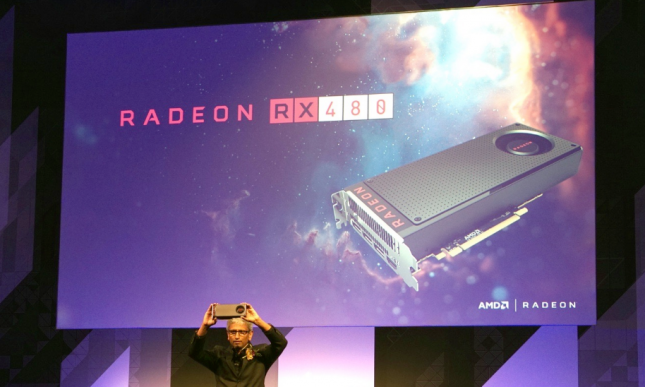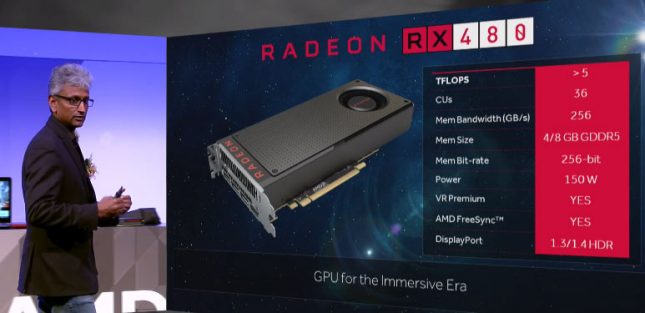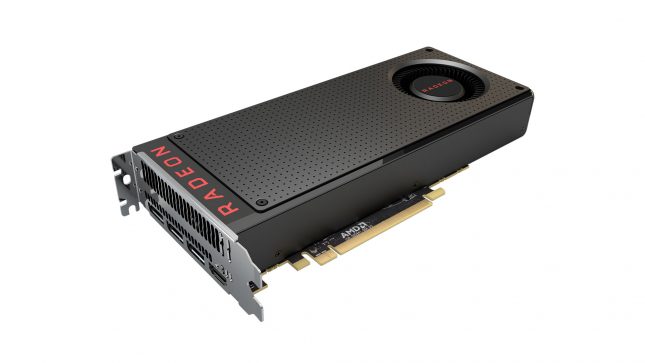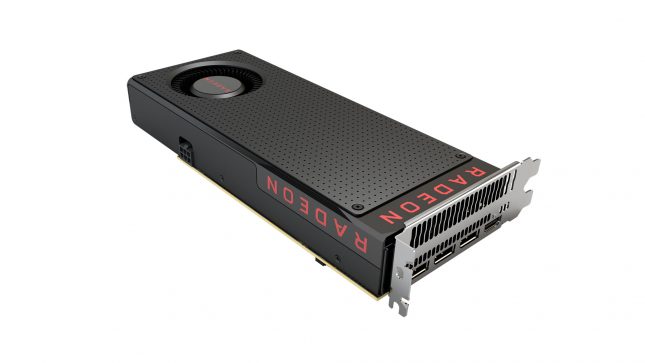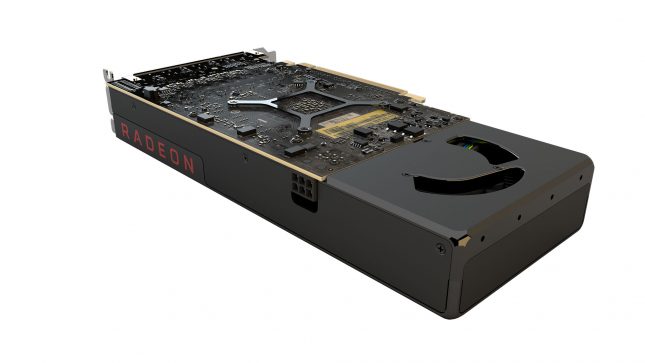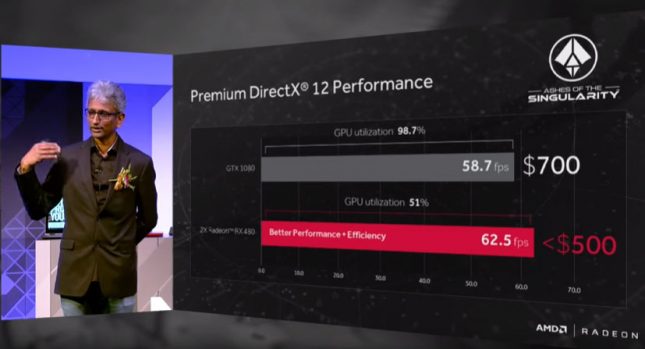AMD Radeon RX 480 Polaris Video Card Coming For $199 To Compete Against GeForce GTX 1070
Today at Computex in Taipei, AMD unveiled its plan for the upcoming Polaris architecture-based Radeon RX Series graphics cards. These cards are aimed at bringing high performance levels at a low cost, and delivering excellent VR capability. Since VR is already expensive to invest into, AMD wants to make it just a bit more affordable with this card.
The Radeon RX 480 is built on the 14nm FinFET process by Global Foundaries and utilizes the Polaris 10 GPU. AMD noted that the Radeon RX 480 has a theoretical performance of greater than 5 Tflops with 36 CUs and 2,304 stream processors if there are still 64 stream processors per CU like the current GCN architecture. The clock speeds of the AMD Radeon RX 480 demo cards in Macau were running 1266 MHz on the cores and the GDDR5 memory was running at 2000MHz or 8Gbps.
We’ve been told the final clock speeds aren’t set though and that is why the >5 TFLOPS of compute performance figure isn’t locked down to a set figure. The AMD Radeon RX 480 will be available in 4GB and 8GB GDDR5 flavors and uses a 256-bit bus and just so happens to have a memory bandwidth of 256 GB/s. The AMD Radeon RX 480 will launch on June 29th with prices starting at $199 for the 4GB models.
This puts the Radeon RX 480 somewhat close to the GeForce GTX 1070 and right on top of the R390/390X performance at a fraction of the price. Now while these numbers look good on paper, we will have to actually wait for benchmarks to find out where it comes in terms of performance. If AMD can get performance above the NVIDIA GeForce GTX 1070 ($379) for only $199 it will really shake up the discrete video card market!
Featuring only a single 6-pin power connector along the top edge of the card, it will be interesting to see how this 150W TDP card overclocks with the new Polaris GPU architecture. The theoretical numbers that we saw could possibly put a little pressure on NVIDIA and its $379 GeForce GTX 1070, and maybe a tiny bit on the GeForce GTX 1080. We will likely have to wait for an RX 480X variant to start putting pressure on the higher-end market.
The AMD Radeon RX 480 will has DisplayPort 1.3/1.4 HDR video outputs, support AMD FreeSync and is labeled as a ‘VR Premium’ product. If this card performs as good as AMD is saying it could really lower the entry costs to setting up a VR system!
AMD also showed off a benchmark of Ashes of the Singularity (DX12 Demo), comparing 2x Radeon RX 480s to a GeForce GTX 1080. While the GeForce GTX 1080 was chugging away at 98.7% utilization, it reached 58.7 fps, but the RX 480s Crossfire solution nailed 62.5 fps at 51% utilization. Now while watching the demo on screen, we saw what appears to be AMD running a much lower quality setting on the RX 480, as there was nowhere near the same amount of detail on the screen compared to the NVIDIA GeForce GTX 1080. This is where an apples-to-apples comparison will really tell us what’s up.
You will be able to pick up the 4GB (GDDR5) RX 480 for $199 starting June 29th! Details of the 8GB version were not announced during the presentation.
You can watch the entire presentation above and check out the press release that went out on the wire below.
AMD (NASDAQ: AMD) today unveiled the companys strategy for its upcoming Polaris architecture-based Radeon RX Series graphics cards, introducing impressive levels of VR performance and future-proof technologies1 at a variety of price points. The Radeon RX 480 delivers premium VR capability at a stunning price of starting at just $199 for the 4GB edition.
Set for launch and availability on June 29th, the Radeon RX 480 will deliver the worlds most affordable solution for premium PC VR experiences, delivering VR capability common in $500 GPUs.
VR is the most eagerly anticipated development in immersive computing ever, and is the realization of AMDs Cinema 2.0 vision that predicted the convergence of immersive experiences and interactivity back in 2008, said Raja Koduri, senior vice president and chief architect, Radeon Technologies Group, AMD. As we look to fully connect and immerse humanity through VR, cost remains the daylight between VR being only for the select few, and universal access for everyone. The Radeon RX Series is a disruptive technology that adds rocket fuel to the VR inflection point, turning it into a technology with transformational relevance to consumers.
In a notable market survey, price was a leading barrier to adoption of VR.2 The $199 starting SEP for select Radeon RX Series GPUs is an integral part of AMDs strategy to dramatically accelerate VR adoption and unleash the VR software ecosystem. AMD expects that its aggressive pricing will jumpstart the growth of the PC VR TAM and accelerate the rate at which VR headsets drop in price:
- More affordable VR-ready desktops and notebooks: AMD expects that affordable PC VR enabled by Polaris architecture-based graphics cards will drive a wide range of VR-ready desktops and notebooks, providing a catalyst for the expansion of the addressable market to an estimated 100 million consumers over the next 10 years.4
- Making VR accessible to consumers in retail: Thus far, retail has not been a viable channel for VR sales as average system costs exceeding $9993 have precluded VR-ready PCs from seeing substantial shelf space. The Radeon RX Series graphics cards will enable OEMs to build ideally priced VR-ready desktops and notebooks well suited for the retail PC market.
- Unleashing VR developers on a larger audience: Adoption of PC VR technologies by mainstream consumers is expected to spur further developer interest across the ecosystem, unleashing new VR applications in education, entertainment, and productivity as developers seek to capitalize on the growing popularity of the medium.
- Reducing the cost of entry to VR: AMD expects that affordable PC VR enabled by Polaris architecture-based graphics cards will dramatically accelerate the pace of the VR ecosystem, driving greater consumer adoption, further developer interest, and increased production of HMDs, ultimately resulting in a lower cost of entry as prices throughout the VR ecosystem decrease over time.
The Radeon RX series efficiency is driven by major architectural improvements and the industrys first 14nm FinFET process technology for discrete GPUs, and could mark an important inflection point in the growth of virtual reality, said Patrick Moorhead, principal analyst, Moor Insights & Strategy. By lowering the cost of ownership and increasing the VR TAM, Radeon RX Series has the potential to propel VR-ready systems into retail in higher volumes, drive new levels of VR content investment, and even drive down the cost of VR headsets.
We congratulate AMD for bringing a premium VR ready GPU to market at a $199 price point, said Dan OBrien, vice president of virtual reality, HTC. This shows how partners like AMD survey the entire VR ecosystem to bring an innovative Radeon RX Series product to power high end VR systems like the HTC Vive, to the broadest range of consumers.
Weve seen an incredible range of immersive applications and game-changing experiences that have given millions of people around the world their first taste of virtual reality, said Nate Mitchell, VP of Product, Oculus. AMD is going to help drive that adoption forward even more by bringing their high-end VR GPUs to the $199 price point.
The Radeon RX Series launch represents the first salvo in AMDs new Water Drop strategy aimed at releasing new graphics architectures in high volume segments first to support continued market share growth for Radeon GPUs. In May 2016, Mercury Research reported that AMD gained 3.2% market share in discrete GPUs in Q1 20165. The Radeon RX Series will address a substantial opportunity in PC gaming: more than 13.8 million PC gamers who spend $100-300 to upgrade their graphics cards, and 84% of competitive and AAA PC gamers6. With Polaris architecture-based Radeon RX Series graphics cards, AMD intends to redefine the gaming experience in its class, introducing dramatically improved performance and efficiency, support for compelling VR experiences, and incredible features never before possible at these prices.
For more information on Polaris architecture-based Radeon RX Series graphics cards availability later this month, stay tuned to the AMD newsroom and associated social media channels.

